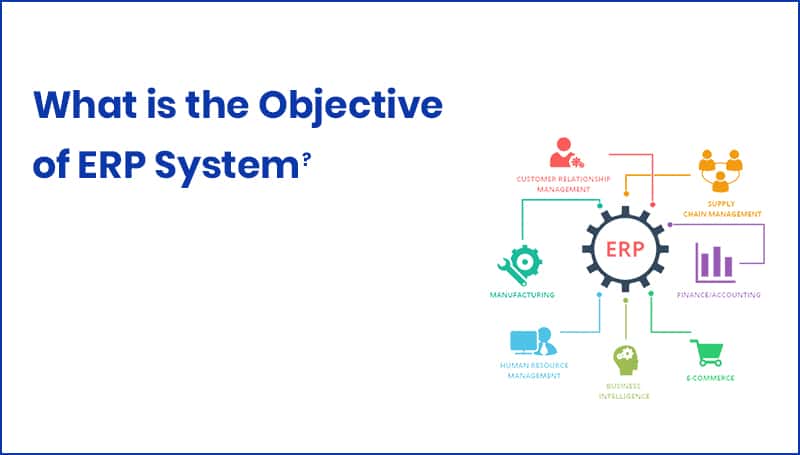What is the Objective of ERP System?
- ERP (Cloud) October 24,2023

Enterprise resource planning (ERP) refers to a kind of software that organizations use to manage day-to-day business activities like accounting, procurement, project management, risk management and compliance, and provide chain operations. When considering an ERP system, it is important to evaluate the specific needs of your organization.
An entire ERP suite also includes enterprise performance management, software that helps plan, budget, predict, and report on an organization’s financial results.
ERP systems tie together a mess of business processes and enable the flow of knowledge between them. ERP systems eliminate data duplication and supply data integrity with one source of truth.
Today, ERP systems are critical for managing thousands of companies of all sizes and altogether industries. To those companies, ERP is indispensable because of the electricity that keeps the lights on.
Advantages and drawbacks
The sheer size, interconnectedness, and complexity of ERP is both a blessing and a curse.
When an ERP system operates efficiently and aligns with a company’s processes, it streamlines operations and uncovers new opportunities. If ERP deployment is delayed or experiences outages, business operations can be disrupted, forcing users to rely on manual solutions. The biggest drawback of ERP is the high risk and cost of failed implementations, often resulting in lawsuits. A notable example is the 2018 lawsuit by Revlon investors, citing SAP ERP issues that disrupted manufacturing and delayed shipments.
Nevertheless, the benefits of ERP usually outweigh the disadvantages. Among the highlights are the following:
Advantages
- ERP can save businesses money over the end of the day by streamlining processes.
- It provides a unified system which will lower IT, labour and training costs.
- It enables greater visibility into critical parts of the business, like sales, capital and inventory.
- It facilitates reporting and planning through improved data and analytics.
- If offers better compliance and security through fine-grained control of user rights and standardized workflows.
Disadvantages
- ERP software is often expensive to deploy and maintain.
- It is usually difficult to implement.
- It requires significant change management.
- ERP modules are often less sophisticated than specialized software and go unused or must get replaced.
Types of ERP Systems
Enterprise Resource Planning (ERP) software is classified as an “enterprise application,” designed to meet the specific software needs of an organization and enhance overall business performance.
Today, various ERP systems cater to different sizes, functions, and organizational needs. Common deployment options include cloud ERP, on-premise ERP, and hybrid ERP (a combination of both).
Each ERP solution can be customized to address different business functions and meet specific organizational requirements.
Big Business ERP vs. Small Business ERP
In the past, “big business ERP” addressed large organizations that always deployed onsite/on-premise ERP solutions and had an abundance of resources to dedicate thereto and other support to research, customize, upgrade and deploy their software solutions.
The phrase “Small Business ERP” or “SME (small and medium-sized enterprise) ERP” commonly mentioned ERP software systems with business management applications typically created to satisfy the precise needs for a little too mid-sized business.
Today, these phrases are used less frequently because the important factor isn’t company size but determining if the ERP system is effectively addressing current and future business requirements, regardless of the dimensions of the organization.
It’s imperative that organizations consider and choose ERP systems that eliminate the necessity for costly customizations, adapt to the rapid pace of business change, address future technologies and meet other identified requirements.
Types of ERP Systems: Cloud vs. On-Premise vs. Hybrid
There are three main sorts of ERP systems that function with different deployment model options. The foremost common sorts of ERP systems include cloud ERP, on-premise ERP, and hybrid ERP.
On-Premise ERP software is implemented onsite and maintained in physical office space within a corporation, hosted on the company’s own computers and servers for full control, support and ownership of the whole system once implemented.
Cloud-based ERP software may be a web-based solution, referred to as Software as a Service (SaaS), where a corporation accesses and stores data on any device with an online connection, usually through the acquisition of a subscription. Continual support, updates, training, and versatile customizations supported by the software provider.
These models can provide ERP users with the pliability to migrate between delivery models, or integrate benefits not available existing implementation.
Different ERP vendors support different deployment model options. Combinations of options, often mentioned as “hybrid” deployment may offer a mixture of hosting and deployment services. These models can provide ERP users’ flexibility to migrate between delivery models, or integrate benefits not available existing implementation.









 Saudi Arabia (English)
Saudi Arabia (English) United Kingdom
United Kingdom Global Site
Global Site